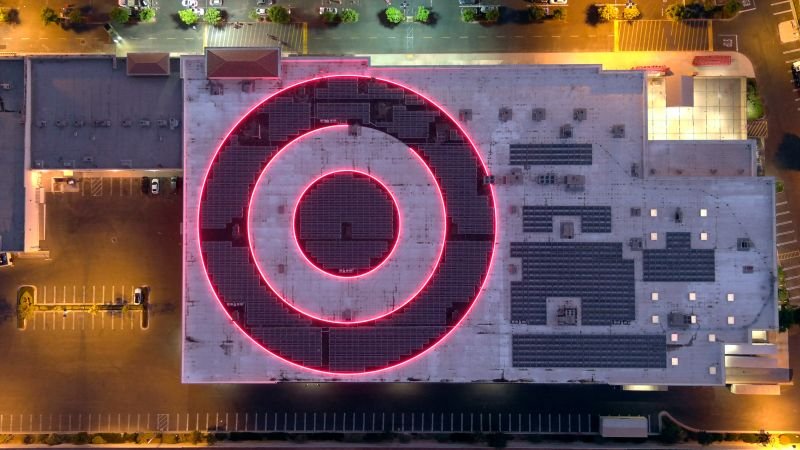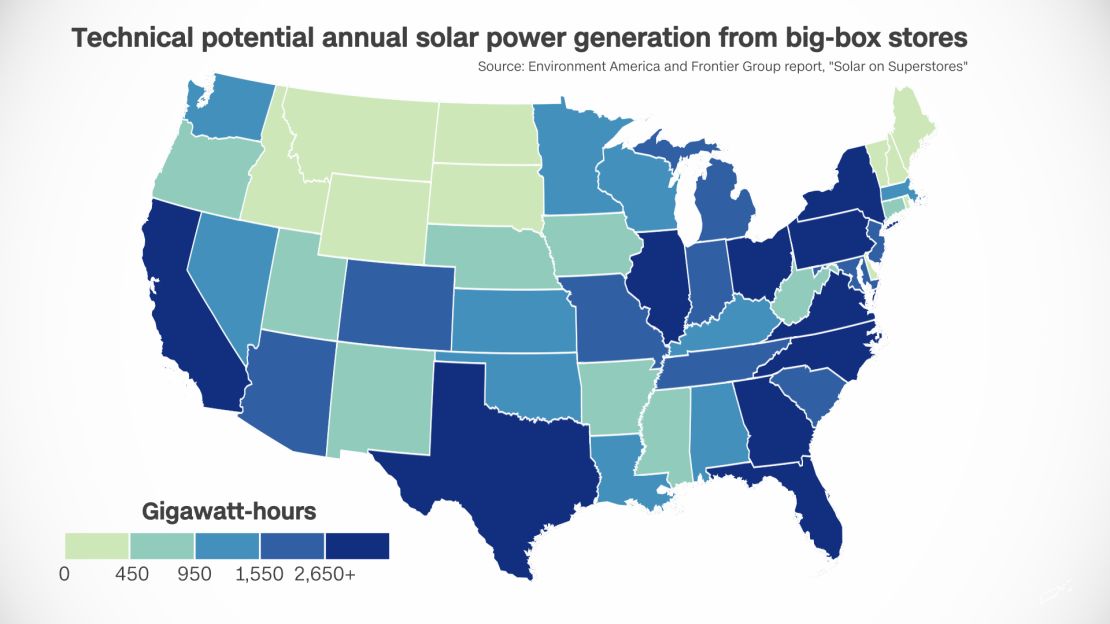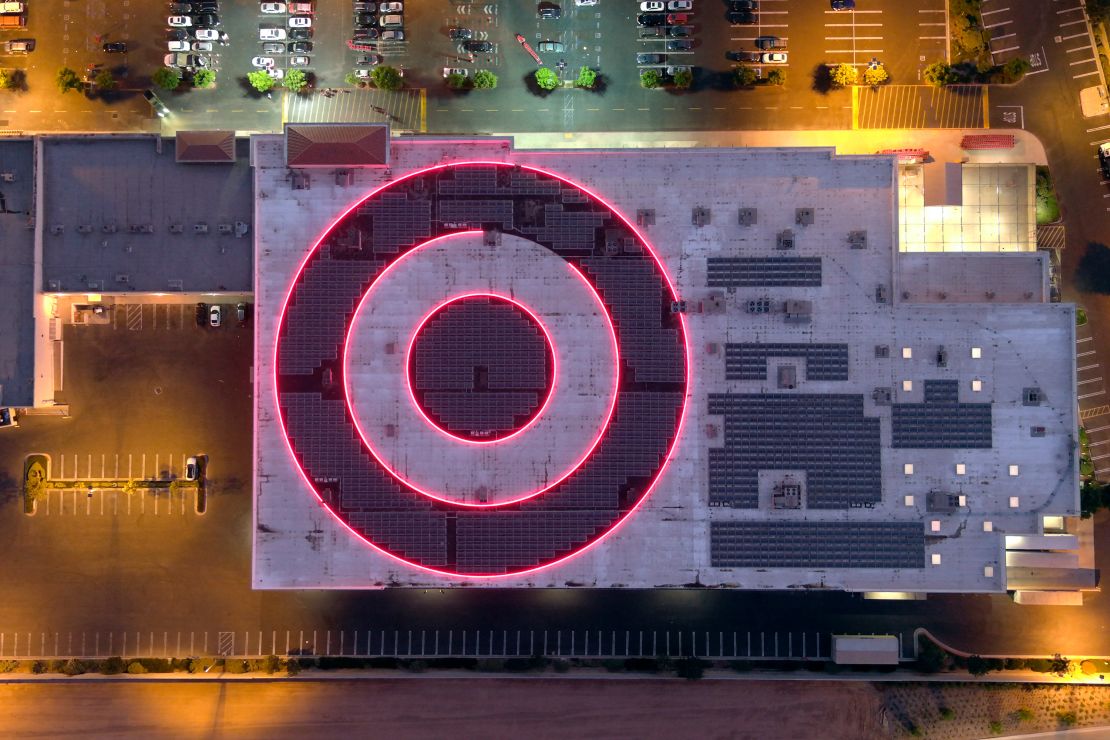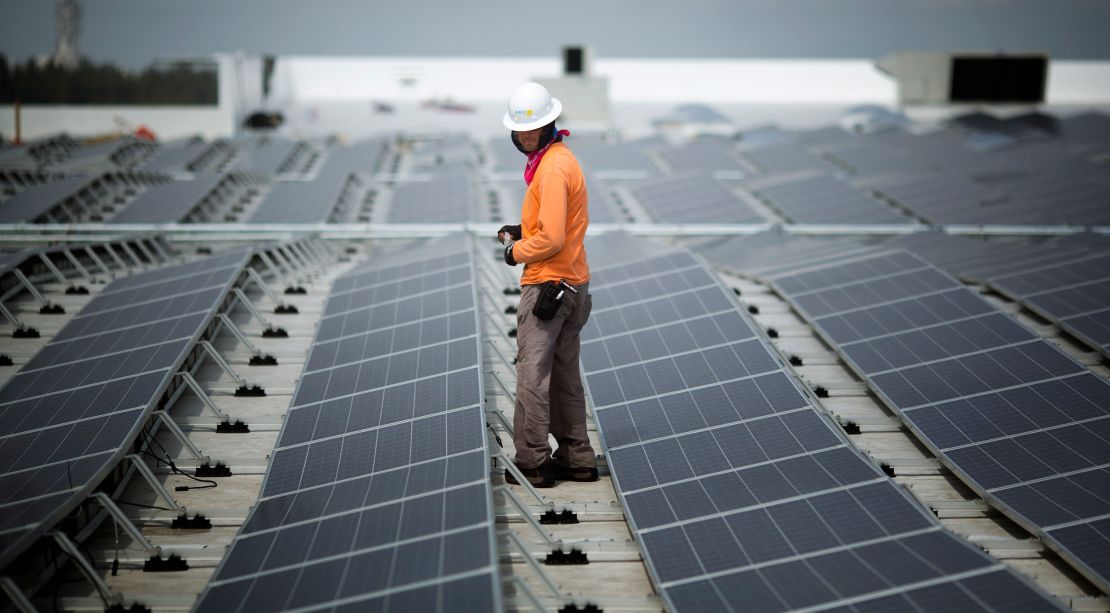Massive-box shops might assist slash emissions and save tens of millions by putting in photo voltaic panels on their roofs. So why aren’t extra of them doing it?

CNN
—
Because the US makes an attempt to wean itself off its heavy reliance on fossil fuels and shift to cleaner power sources, many consultants are eyeing a promising resolution: your neighborhood big-box shops and procuring malls.
The rooftops and parking zone area out there at retail giants like Walmart, Goal and Costco is very large. And these largely empty areas are being touted as untapped potential for solar energy that would assist the US scale back its dependency on international power, slash planet-warming emissions and save firms tens of millions of {dollars} within the course of.
On the IKEA retailer in Baltimore, putting in photo voltaic panels on the roof and over the shop’s parking zone minimize the quantity of power it wanted to buy by 84%, slashing its prices by 57% from September to December of 2020, in keeping with the corporate. (The panels additionally present some useful shade to maintain clients’ vehicles cool on scorching, sunny days.)
As of February 2021, IKEA had 54 photo voltaic arrays put in throughout 90% of its US areas.
Massive-box shops and procuring facilities have sufficient roof area to supply half of their annual electrical energy wants from photo voltaic, in keeping with a report from nonprofit Atmosphere America and analysis agency Frontier Group.
Leveraging the total rooftop photo voltaic potential of those superstores would generate sufficient electrical energy to energy almost 8 million common houses, the report concluded, and would minimize the identical quantity of planet-warming emissions as pulling 11.3 million gas-powered vehicles off the highway.
The common Walmart retailer, for instance, has 180,000 sq. ft of rooftop, in keeping with the report. That’s roughly the dimensions of three soccer fields and sufficient area to help photo voltaic power that would energy the equal of 200 houses, the report mentioned.
“Each rooftop in America that isn’t producing photo voltaic power is a rooftop wasted as we work to interrupt our dependence on fossil fuels and the geopolitical conflicts that include them,” Johanna Neumann, senior director for Atmosphere America’s marketing campaign for 100% Renewable, advised CNN. “Now could be the time to lean into native renewable power manufacturing, and there’s no higher place than the roofs of America’s big-box superstores.”

Advocates concerned in clear power worker-training packages inform CNN {that a} photo voltaic revolution in big-box retail would even be a major windfall for native communities, spurring financial development whereas tackling the local weather disaster, which has inflicted disproportionate hurt on marginalized communities.
But solely a fraction of big-box shops within the US have photo voltaic on their rooftops or photo voltaic canopies in parking tons, the report’s authors advised CNN.
CNN reached out to 5 of the highest US retailers — Walmart, Kroger, House Depot, Costco and Goal — to ask: Why not put money into extra rooftop photo voltaic?
Many renewable power consultants level to photo voltaic as a comparatively easy resolution to chop down on prices and assist rein in fossil gas emissions, however the firms level to a number of roadblocks — laws, labor prices and structural integrity of the rooftops themselves — which might be stopping extra widespread adoption.
The necessity for these sorts of unpolluted power initiatives is changing into “unquestionably pressing” because the local weather disaster accelerates, mentioned Edwin Cowen, professor of civil and environmental engineering at Cornell College.
“We’re behind the eight ball, to place it mildly,” Cowen advised CNN. “I might have beloved to see coverage assist incentivize rooftop photo voltaic 15 years in the past as a substitute of 5 years in the past within the industrial area. There’s nonetheless an incredible quantity of labor to do.”
Neumann mentioned Walmart, the nation’s largest retailer, possesses by far the biggest photo voltaic potential. Walmart has round 5,000 shops within the US and greater than 783 million sq. ft of rooftop area — an space bigger than Manhattan — and greater than 8,974 gigawatt hours of annual rooftop photo voltaic potential, in keeping with the report.
It’s sufficient electrical energy to energy greater than 842,000 houses, the report mentioned.
Walmart spokesperson Mariel Messier advised CNN the corporate is concerned in renewable power tasks all over the world, however a lot of them are usually not rooftop photo voltaic installations. The corporate has reported having accomplished on- and off-site wind and photo voltaic tasks or had others below growth with a capability to supply greater than 2.3 gigawatts of renewable power.
Neumann mentioned Atmosphere America has met with Walmart a number of instances, urging the retailer to decide to putting in photo voltaic panels on roofs and in parking tons. The corporate has mentioned it’s aiming to supply 100% of its power by means of renewable tasks by 2035.
“Of all of the retailers in America, Walmart stands to make the largest impression in the event that they put rooftop photo voltaic on all of their shops,” Neumann advised CNN. “And for us, this report simply underscores simply how a lot of an impression they may make in the event that they make that call.”
In keeping with Atmosphere America, Walmart had put in nearly 194 megawatts of photo voltaic capability on its US services as of the tip of the 2021 fiscal 12 months and extra capability in off-site photo voltaic farms. The corporate’s installations in California had been anticipated to supply between 20% to 30% of every location’s electrical energy wants.

Goal ranked No. 1 for on-site photo voltaic capability in 2019, in keeping with business commerce group Photo voltaic Power Industries Affiliation’s most up-to-date report. It presently has 542 areas with rooftop photo voltaic — round 1 / 4 of the corporate’s shops — a Goal spokesperson advised CNN. Rooftop photo voltaic generates sufficient power to satisfy 15% to 40% of Goal properties’ power wants, the spokesperson mentioned.
Richard Galanti, the chief monetary officer at Costco, mentioned the corporate has 121 shops with rooftop photo voltaic all over the world, 95 of that are within the US.
Walmart, Goal and Costco didn’t share with CNN what their greatest boundaries are to including rooftop or parking zone photo voltaic panels to extra shops.
Approximate variety of households firms might energy with rooftop photo voltaic
“My suspicion is that they need a good stronger enterprise case for deviating from business-as-usual,” Neumann mentioned. “Traditionally, all these roofs have finished is canopy their shops, and rethinking how [they] use their buildings and considering of them as power mills, not simply safety from rain, requires a small change of their enterprise mannequin.”
House Depot, which has round 2,300 shops, presently has 75 accomplished rooftop photo voltaic tasks, 12 in building and greater than 30 deliberate for future growth, mentioned Craig D’Arcy, the corporate’s director of power administration. Solar energy generates round half of those shops’ power wants on common, he mentioned.
Growing old rooftops at shops are a “enormous obstacle” to photo voltaic set up, D’Arcy added. If a roof must be changed within the subsequent 15 to twenty years or sooner, it doesn’t make monetary sense for House Depot so as to add photo voltaic techniques immediately, he mentioned.
“We have now a objective of implementing photo voltaic rooftop the place the economics are enticing,” D’Arcy advised CNN.
CNN additionally reached out to Kroger, which owns about 2,800 shops throughout the US. Kristal Howard, a Kroger spokesperson, mentioned the corporate presently has 15 properties — shops, distribution facilities and manufacturing vegetation — with photo voltaic installations. One of many “a number of components affecting the viability of a photo voltaic set up” was the shops’ means to help a photo voltaic set up on the roofs, Howard mentioned.

Cowen, the engineering professor at Cornell, mentioned photo voltaic is already enticing, however that labor prices, incentives and the totally different layers of regulation doubtless pose some monetary challenges in photo voltaic installations.
“For them, this implies normally hiring a neighborhood website agency that may do this set up that additionally is aware of native coverage,” Cowen mentioned. “It’s simply one other layer of complexity that I believe is starting to make sense as a result of the prices have come down sufficient, however it wants type of reopening that door of moving into an current constructing.”
Rep. Sean Casten of Illinois, who co-chairs the energy sector activity drive within the Home, mentioned the US has “failed to supply the incentives to individuals who have the experience to go in and construct this stuff.” The explanation each retail firms and the facility sector haven’t made a lot progress on photo voltaic is as a result of “our system is so disjointed” and has a posh regulation construction, Casten mentioned.
“Why aren’t we doing one thing that makes financial sense? The reply is that this horribly disjointed federal coverage the place we massively subsidize fossil power extraction, and we penalize clear power manufacturing,” Casten advised CNN. “For a protracted, very long time, should you wished to construct a photo voltaic panel on the rooftop of Walmart, your greatest enemy was going to be your native utility as a result of they didn’t wish to lose the load.
“We might have finished this many years in the past,” Casten added. “And had we finished it, we might not be on this dire place with the local weather, however we’d even have much more cash in our pocket.”
For Charles Callaway, director of organizing on the nonprofit group WE ACT for Environmental Justice, strengthening the rooftop photo voltaic capability in large field retail shops is a no brainer, particularly if firms enable the local people to reap advantages both by means of set up jobs or sharing the electrical energy produced later.
Both means, it might put a large dent in curbing the local weather disaster and assist usher in an equitable transition away from fossil fuels — and it’s doable, Callaway advised CNN.

The New York Metropolis resident led a employee coaching program that helped practice greater than 100 local people members, largely individuals of colour, to turn into photo voltaic installers. He additionally fashioned a photo voltaic staff cooperative to make sure most of the members of the coaching program get jobs in a troublesome market.
Within the final two years, Callaway mentioned his group has not solely put in photo voltaic panels on roofs of reasonably priced housing models, but in addition gear able to producing 2 megawatts of photo voltaic power on procuring malls up in upstate New York. He emphasised that hiring regionally can be most useful since native installers know the neighborhood and native laws finest.
“One in every of my enormous issues is social fairness,” Cowen mentioned. “Entry to renewable power is a reasonably privileged place nowadays, and we’ve received to determine methods to make that not true.”
Jasmine Graham, WE ACT’s power justice coverage supervisor, mentioned the potential of constructing rooftop photo voltaic on large field superstores is encouraging, solely “if these tasks use native labor, if they’re paying prevailing wages, and if this photo voltaic is being utilized in a fashion corresponding to neighborhood photo voltaic, which might enable [utility] invoice reductions for folk that dwell in the identical utility zone.”
Strain is mounting for world leaders to behave urgently on the local weather disaster after a UN report in late February warned the window for motion is quickly closing.
Neumann believes the US can meet its power demand with renewables. All it takes, she mentioned, is the political will to make that swap, and the inclusion of the local people so nobody will get left behind within the transition.
“The earlier we make that transition, the earlier we’ll have cleaner air, the earlier we’ll have a extra protected surroundings and higher well being and the earlier we’ll have a extra livable future for our youngsters,” Neumann mentioned. “And even when that requires funding, it’s an funding price making.”






